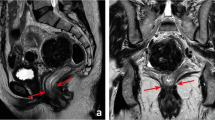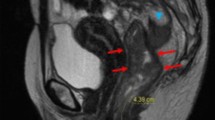Abstract
Purpose
The aim of this study was to compare the localization of rectal cancers as classified according to the general rules of the Japanese classification of colorectal carcinoma (JCCRC) and also according to the European Society for Medical Oncology (ESMO) and the National Comprehensive Cancer Network (NCCN) guidelines, which are based on rigid endoscopic measurements.
Methods
The medical records of patients scheduled to receive curative surgery for histologically proven rectal adenocarcinoma during 2009–2015 were investigated (n = 230). Rigid proctoscopy was performed in patients with rectal cancer located in the upper (Ra) or lower (Rb) division using double-contrast barium enema.
Results
The median values of height from the anal verge were 7.5 cm (range 2–12) and 3 cm (0–9.5) on rigid proctoscopy for cancers assigned as Ra and Rb, respectively. All 159 cancers at Ra or Rb were located within 12 cm from the anal verge by rigid proctoscopy, while only 79.7% of Ra or 82.1% of Rb cancers were located in the mid (5.1–10 cm) or low (≤5 cm) rectum, respectively.
Conclusion
Ra and Rb cancers are deemed to be rectal cancers according to NCCN guidelines, but these classifications are not interchangeable with mid- and low-rectal cancers, respectively, according to the ESMO guidelines.



Similar content being viewed by others
References
Abdelsattar ZM, Reames BN, Regenbogen SE, Hendren S, Wong SL. Critical evaluation of the scientific content in clinical practice guidelines. Cancer. 2015;121(5):783–9.
Katayama H, Kurokawa Y, Nakamura K, Ito H, Kanemitsu Y, Masuda N, et al. Extended Clavien-Dindo classification of surgical complications: Japan Clinical Oncology Group postoperative complications criteria. Surg Today. 2016;46(6):668–85.
Hori M, Matsuda T, Shibata A, Katanoda K, Sobue T, Nishimoto H. Cancer incidence and incidence rates in Japan in 2009: a study of 32 population-based cancer registries for the Monitoring of Cancer Incidence in Japan (MCIJ) project. Jpn J Clin Oncol. 2015;45(9):884–91.
Maeda K, Koide Y, Katsuno H. When is local excision appropriate for “early” rectal cancer? Surg Today. 2014;44(11):2000–14.
Schmoll HJ, Van Cutsem E, Stein A, Valentini V, Glimelius B, Haustermans K, et al. ESMO Consensus Guidelines for management of patients with colon and rectal cancer. A personalized approach to clinical decision making. Ann Oncol. 2012;23(10):2479–516.
National Comprehensive Cancer Network. Clinical Practice Guidelines in Oncology, Colorectal Cancer Screening (version 2.2016); 2016.
American Joint Committee on Cancer. AJCC cancer staging manual. 6th ed. New York: Springer; 2002.
Pilipshen SJ, Heilweil M, Quan SH, Sternberg SS, Enker WE. Patterns of pelvic recurrence following definitive resections of rectal cancer. Cancer. 1984;53(6):1354–62.
Milsom JW, Cho H-J. Restorative Procedures. In: Audisio RA, Geraghty JG, Longo WE, editors. Modern management of cancer of the rectum. Great Britain: Springer London; 2001. pp. 63–78.
Japanese Society for Cancer of the Colon and Rectum. Japanese Classification of Colorectal Carcinoma, Second English ed. Tokyo: Kanehara & Co., Ltd; 2009.
Noura S, Ohue M, Ito Y, Miyoshi N, Kobayashi H, Kotake K, et al. New staging system for colorectal cancer patients with synchronous peritoneal metastasis in accordance with the japanese classification of colorectal carcinoma: a multi-institutional study. Dig Surg. 2016;33(1):66–73.
Rubesin SE, Levine MS, Laufer I, Herlinger H. Double-contrast barium enema examination technique. Radiology. 2000;215(3):642–50.
Farrands PA, Vellacott KD, Amar SS, Balfour TW, Hardcastle JD. Flexible fiberoptic sigmoidoscopy and double-contrast barium-enema examination in the identification of adenomas and carcinoma of the colon. Dis Colon Rectum. 1983;26(11):725–7.
R Core Team. R: A language and environment for statistical computing. 2015. https://www.r-project.org/. Accessed Feb 18 2016.
Monson JRT, Weiser MR, Chang GJ, Buie WD, Rafferty J. Practice parameters for the management of rectal cancer (revised). Dis Colon Rectum 2013;56(5):535–50.
Hildebrandt U, Feifel G. Preoperative staging of rectal cancer by intrarectal ultrasound. Dis Colon Rectum. 1985;28(1):42–6.
Najarian MM, Belzer GE, Cogbill TH, Mathiason MA. Determination of the peritoneal reflection using intraoperative proctoscopy. Dis Colon Rectum. 2004;47(12):2080–5.
Memon S, Keating JP, Cooke HS, Dennett ER. A study into external rectal anatomy: improving patient selection for radiotherapy for rectal cancer. Dis Colon Rectum. 2009;52(1):87–90.
Thumbe V, Iqbal M, Bhalerao S. Accuracy of digital rectal examination in the estimation of height of rectal lesions. Tech Coloproctol. 2007;11(2):111–3.
Baatrup G, Bolstad M, Mortensen JH. Rigid sigmoidoscopy and MRI are not interchangeable in determining the position of rectal cancers. Eur J Surg Oncol. 2009;35(11):1169–73.
Lee S-H, Hernandez de Anda E, Finne C, Madoff R, Garcia Aguilar J. The effect of circumferential tumor location in clinical outcomes of rectal cancer patients treated with total mesorectal excision. Dis Colon Rectum. 2005;48(12):2249–57.
Kim YW, Cha SW, Pyo J, Kim NK, Min BS, Kim MJ, et al. Factors related to preoperative assessment of the circumferential resection margin and the extent of mesorectal invasion by magnetic resonance imaging in rectal cancer: a prospective comparison study. World J Surg. 2009;33(9):1952–60.
Heald RJ, Husband EM, Ryall RD. The mesorectum in rectal cancer surgery–the clue to pelvic recurrence? Br J Surg. 1982;69(10):613–6.
Sauer R, Becker H, Hohenberger W, Rodel C, Wittekind C, Fietkau R, et al. Preoperative versus postoperative chemoradiotherapy for rectal cancer. N Engl J Med. 2004;351(17):1731–40.
Bosset JF, Collette L, Calais G, Mineur L, Maingon P, Radosevic-Jelic L, et al. Chemotherapy with preoperative radiotherapy in rectal cancer. N Engl J Med. 2006;355(11):1114–23.
Collette L, Bosset JF, den Dulk M, Nguyen F, Mineur L, Maingon P, et al. Patients with curative resection of cT3-4 rectal cancer after preoperative radiotherapy or radiochemotherapy: does anybody benefit from adjuvant fluorouracil-based chemotherapy? A trial of the European Organisation for Research and Treatment of Cancer Radiation Oncology Group. J Clin Oncol. 2007;25(28):4379–86.
Uehara K, Nagino M. Neoadjuvant treatment for locally advanced rectal cancer: a systematic review. Surg Today. 2016;46(2):161–8.
Hasegawa S, Takahashi R, Hida K, Kawada K, Sakai Y. Transanal total mesorectal excision for rectal cancer. Surg Today. 2016;46(6):641–53.
Sadahiro S, Suzuki T, Tanaka A, Okada K, Kamijo A, Murayama C, et al. Phase I/II study of preoperative concurrent chemoradiotherapy with S-1 for locally advanced, resectable rectal adenocarcinoma. Int Soc Cell. 2011;81(5–6):306–11.
Suzuki T, Sadahiro S, Tanaka A, Okada K, Kamata H, Kamijo A, et al. Biopsy specimens obtained 7 days after starting chemoradiotherapy (CRT) provide reliable predictors of response to CRT for rectal cancer. Int J Radiat Oncol Biol Phys. 2013;85(5):1232–8.
Sadahiro S, Suzuki T, Tanaka A, Okada K, Saito G, Kamijo A, et al. Phase II study of preoperative concurrent chemoradiotherapy with S-1 plus bevacizumab for locally advanced resectable rectal adenocarcinoma. Int Soc Cell. 2015;88(1):49–56.
Author information
Authors and Affiliations
Corresponding author
Ethics declarations
Conflict of interest
No authors have any conflicts of interest to declare.
Rights and permissions
About this article
Cite this article
Tanaka, A., Sadahiro, S., Suzuki, T. et al. A comparison of the localization of rectal carcinomas according to the general rules of the Japanese classification of colorectal carcinoma (JCCRC) and Western guidelines. Surg Today 47, 1086–1093 (2017). https://doi.org/10.1007/s00595-017-1487-9
Received:
Accepted:
Published:
Issue Date:
DOI: https://doi.org/10.1007/s00595-017-1487-9




